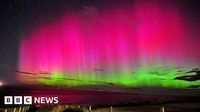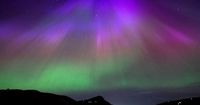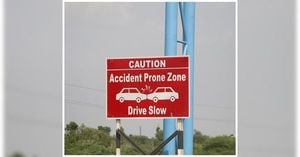For skywatchers across the United Kingdom, the start of September 2025 brought an extraordinary celestial treat: the Northern Lights, or aurora borealis, danced across much of the country in a rare and vivid display. While northern Scotland is no stranger to such phenomena, this week’s solar storm meant that even residents as far south as Kent and Norfolk caught a glimpse of the ethereal greens, pinks, and purples that usually grace the Arctic skies.
The dazzling show was set in motion by a powerful coronal mass ejection (CME) that erupted from the Sun’s corona—the star’s outermost layer—on August 30, 2025. According to the Met Office, a CME is essentially a massive explosion of plasma and magnetic field, and when one of these energetic clouds is hurled toward Earth, it can spark geomagnetic storms. These storms, in turn, are responsible for the aurora’s dramatic appearance. The CME’s journey of nearly 90 million miles concluded late on September 1 or early on September 2, when it slammed into Earth’s magnetic field, igniting a spectacle that was visible across the UK and even parts of the United States.
BBC News reported that satellites monitoring solar activity detected the eruption over the weekend, prompting space weather forecasters to raise the alert for an impending aurora. The US Space Weather Prediction Center confirmed the arrival of a “moderate geomagnetic storm”—classified as G2 on a scale from G1 (minor) to G5 (extreme)—in the early hours of Tuesday. The Met Office Space Weather Centre suggested that solar activity could intensify even further, with a real possibility of the storm reaching G4 (severe) levels, which would make the aurora visible even to the naked eye across the entire UK.
“As we monitor the arrival of this coronal mass ejection, there is a real possibility of aurora sightings further south than usual on Monday night,” Krista Hammond, Met Office space weather manager, explained. “While the best views are likely further north, anyone with clear, dark skies should keep an eye out. Forecasts can change rapidly, so we encourage the public to stay updated with the latest information.”
Indeed, the unpredictability of space weather was on full display. The Met Office highlighted that predictions about solar activity can shift quickly after a CME, so those hoping to catch the aurora were urged to remain vigilant. The best opportunities for viewing were expected on the nights of September 1 and 2, with lingering chances as late as September 3. However, visibility was also at the mercy of earthly factors: cloud cover increased as the week progressed, with the Midlands enjoying the clearest skies on Monday, while northern Scotland and northern England had the best prospects on Tuesday and Wednesday nights.
But even with a powerful solar storm overhead, not everyone was guaranteed a front-row seat. Light pollution from urban areas and a waxing gibbous moon threatened to wash out the delicate colors of the aurora, making rural, dark-sky locations the best bet for a memorable sighting. The Met Office noted, “Photographs of the aurora can often make the lights look better than they do with the naked eye for people who have trouble seeing them.” For those in cities or under cloudy skies, cameras with long exposure settings sometimes captured what human eyes could not.
The science behind the spectacle is as fascinating as the display itself. When a CME reaches Earth, it bombards the planet’s magnetosphere—the protective magnetic bubble that surrounds us. Some of the high-energy particles travel down magnetic field lines toward the poles, where they interact with gases in the upper atmosphere. The resulting collisions produce the vivid lights of the aurora. The color palette depends on which atmospheric molecules are struck: oxygen yields red and green, nitrogen gives pink and red, while hydrogen and helium can create blue and purple hues.
According to The Economic Times, the best places to see the aurora were in the north of the UK, but if the skies were clear, even locations in the Midlands had a shot at witnessing the event. “The best view is probably in the north, but if the skies are clear, something could happen in the middle of England as well,” the Met Office stated. The report also emphasized that the aurora might still be visible on September 3, but the best chances were on September 1 and 2. As the week wore on and solar activity waned, the likelihood of further displays diminished.
For many, the rare southern appearance of the Northern Lights was a once-in-a-lifetime experience. Social media was awash with photos from BBC Weather Watchers and amateur astronomers alike, capturing everything from glowing purple fields to green-lit beaches and lighthouses silhouetted against the shimmering sky. The aurora’s reach was so extensive that it was even visible in north Wales—a testament to the intensity of the solar event.
This particular solar storm was described by scientists as a “cannibal” event, a term used when one CME overtakes and merges with an earlier ejection, amplifying the impact on Earth’s magnetic field. According to the Daily Mail, NOAA’s Space Weather Prediction Center expected the storm to begin as a G1 (minor) to G2 (moderate) event on Monday night, but warned that conditions could intensify to G3 (strong) or even G4 (severe) in the early hours of Tuesday. Such strong geomagnetic storms can occasionally disrupt power grids, as was the case during severe solar storms in Quebec in 1989 and Malmo, Sweden, in 2003, though no major disruptions were reported during this week’s event.
The aurora wasn’t limited to the UK, either. Eighteen US states, from Alaska and Montana to New York and Maine, were also treated to the spectacle, with NOAA noting that the solar storm would shower the Earth with high-energy protons. For both seasoned astronomers and casual stargazers, these rare displays served as a vivid reminder of the Sun’s dynamic influence on our planet.
As the skies gradually returned to normal, forecasters reminded the public that such events are fleeting and unpredictable. But for those lucky enough to have witnessed the Northern Lights over Britain’s fields, coasts, and hills, the memory of this week’s cosmic performance will surely linger long after the colors have faded from the night.






